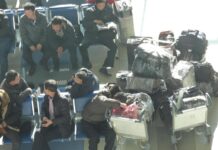Unification Media Group (UMG): It’s time for a weekly recap of North Korea market news with reporter Kang Mi Jin.
Kang Mi Jin (Kang): These days, more and more North Koreans are struggling to get by. As we have mentioned before, a lot of this can be blamed on last year’s poor harvest as well as international sanctions.
Conditions are most difficult for those in the rural areas, where the markets are underdeveloped and not as active as in the major cities. There are more reports now of people who are only able to afford a single meal per day.
UMG: Hopefully, with the coming of spring and the new harvest season, the situation will improve. What else have you heard from sources inside North Korea lately?
Kang: I have heard news that the central authorities are once again placing the burden on ordinary people to collect paint needed for the annual spring ‘city beautification’ projects. A source in the Sadong district of Pyongyang told me that individuals are required to submit 10 kg of paint each.
Spring beautification projects occur annually nationwide, but it’s particularly intense for Pyongyang residents. Buildings across the city require repainting, from government offices to apartments, to storefronts and food stands.
UMG: People must be extremely busy trying to somehow procure the required paint and other materials.
Kang: Yes, that’s right. Some people even cross into China on ‘family visit’ permits to collect materials or request help from family members living there. Others try to purchase ‘Pukhan Mountain Paint’ manufactured in the Yongchon district of South Pyongan Province.
When I lived in North Korea, I also went to Yongchon to buy paint after receiving orders to do so for the construction of a new police building. It’s a small factory, but I heard they produced good-quality paint, and I remember being able to buy some after paying a bribe.
UMG: So while people continue to struggle to survive, the government is once again focused on cosmetic projects. Next, let’s turn to the latest market trends.
Kang: As we know, South Korean people can be very discerning about what they purchase. Instead of just purchasing the cheapest items available, they look for quality items sold at a fair price. This sort of consumer thinking is becoming more and more common in North Korea these days as well.
Previously, similar items were for the most part sold at similar prices in North Korea’s markets, like socks, jackets, and other clothes. But the variety of goods available in the markets has continued to expand.
UMG: So are North Koreans finding it easier to buy the right kinds of items that suit them in terms of style and affordability?
Kang: That’s correct. A source in North Hamgyong Province recently told me that for categories like rice and other grains, produce, manufactured goods, etc., there are now more options available at a wider range of prices. He also said that even for one particular food item, different stalls sell products from different sources and for different prices.
During the 2000s when I was shopping in North Korea’s markets, most socks or clothes for sale were pretty much the same. But now, the price for an item of clothing depends on the quality of fabric, for example.
Interestingly, the prices for a single category of items in the same market can vary widely now. In the past, a merchant could not get away with selling an item for a higher price than their neighboring vendor, but now they can, and it’s all because they are trying harder to predict and match consumer preferences.
UMG: What kinds of items are now being sold at varying prices in the markets?
Kang: First, there are meals sold at food stalls in the markets like cold potato noodle soup. This can cost anywhere from 500 KPW to 6,000 KPW in the markets of Ryanggang Province. For bread, the price depends on the ingredients and supplier. According to the source, 1 kg of ‘university student bread’ costs 5,000 KPW, while homemade bread costs 6,350 KPW, and factory-produced bread costs 19,000 KPW.
The situation is similar for clothing. In the Musan area of North Hamgyong Province, depending on the quality of course, a jacket costs anywhere from 60 or 70,000 KPW all the way up to 180,000 KPW.
In the early part of the decade, the price for a pair of socks was only 2,000 or 2,500 KPW, but now because domestically-manufactured socks are hitting the markets, the prices and variety of styles is expanding. People like North Korean-made socks for their quality and designs, which means that they have become more expensive than other socks.
 All prices shown in KPW and current as of February 27, 2018. Data: Daily NK |


















